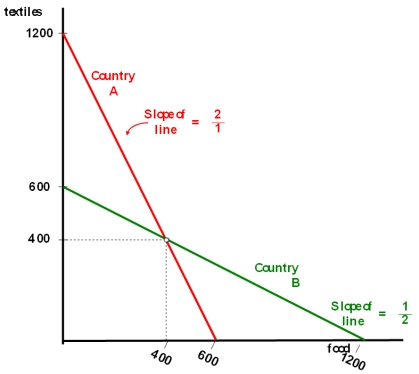Multiple Choice
Counties A and B currently consume 400 units of food and 400 units of textiles each and currently do not trade with one another.The citizens of country A have to give up one unit of food to gain two units of textiles,while the citizens of country B have to give up one unit of textiles to gain two units of food.Their production possibilities curves are shown.  Under the theory of comparative advantage,if free trade is allowed,the market clearing price (or exchange rate if you will) between food and textiles will be
Under the theory of comparative advantage,if free trade is allowed,the market clearing price (or exchange rate if you will) between food and textiles will be
A) one unit of food for one unit of textiles.
B) somewhere between one unit of food for two units of textiles and two units of food for one unit of textiles.
C) one unit of food for two units of textiles.
D) two units of food for one unit of textiles.
Correct Answer:

Verified
Correct Answer:
Verified
Q2: The euro<br>A)is the common currency of Europe.<br>B)is
Q5: In modern times, it is not a
Q11: Privatization<br>A)has spurred a tremendous increase in cross-border
Q27: If the international price of beer is
Q28: Which state has an absolute advantage in
Q42: Comparative advantage<br>A)is also known as relative efficiency.<br>B)can
Q55: Now suppose that Southern workers receive a
Q64: What major dimension sets apart international finance
Q66: Country A can produce 10 yards of
Q93: In David Ricardo's theory of comparative advantage,<br>A)international